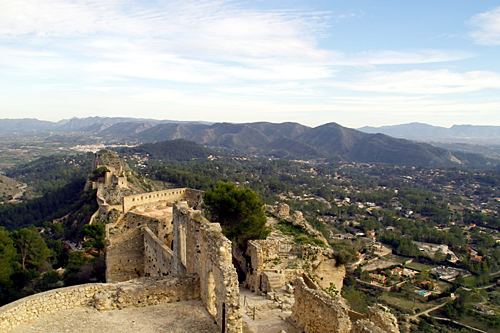Comarca Costera Demonym(s) Setabense Elevation 115 m | Judicial district Xàtiva Time zone CET (UTC+1) Population 29,343 (2014) Local time Sunday 7:46 AM | |
 | ||
Weather 9°C, Wind SW at 3 km/h, 80% Humidity | ||
Xàtiva ([ˈʃativa], [(æj)ˈʃætɪʋæ]; Spanish: Játiva [ˈxatiβa]) is a town in eastern Spain, in the province of Valencia, on the right (western) bank of the river Albaida and at the junction of the Valencia–Murcia and Valencia Albacete railways. During the Al-Andalus Islamic era, Arabs brought the technology to manufacture paper to Xàtiva. In the 12th century, Xàtiva was known for its schools, education, and learning circles. Islamic scholar Abu Ishaq al-Shatibi's last name refers to Xàtiva where he lived and died.
Contents
Map of 46800 X%C3%A0tiva, Valencia, Spain
History
Xàtiva (Saetabis in Latin) was famous in Roman times for its linen fabrics, mentioned by the Latin poets Ovid and Catullus. Xàtiva is also known as an early European centre of paper manufacture. In the 12th century, Arabs brought the technology to manufacture paper to Xàtiva (Arabic: شاطبة Shāṭiba).
It is the birthplace of two popes, Callixtus III and Alexander VI, and also the painter José Ribera (Lo Spagnoletto). It suffered a dark moment in its history at the hands of Philip V of Spain, who, after his victory at the Battle of Almansa during the War of the Spanish Succession, had the city besieged then ordered it to be burned and renamed San Felipe. In memory of the insult, the portrait of the monarch hangs upside down in the local museum of L'Almodí.
Xàtiva was briefly a provincial capital under the short-lived 1822 territorial division of Spain, during the Trienio Liberal. The Province of Játiva was revoked with the return to absolutism in 1823.
Main sights
Xàtiva is built on the margin of a fertile plain, and on the southern slopes of the Monte Vernissa, a hill with two peaks, each surmounted by a Castle of Xàtiva.
The Collegiate Basilica, dating from 1414, but rebuilt about a century later in the Renaissance style, was formerly a cathedral, and is the chief among many churches and convents. The town-hall and a church on the castle hill are partly constructed of inscribed Roman masonry, and several houses date from the Moorish period.
Other sights include:
